Acoustic Energy Harvesting and Sensing via Electrospun PVDF Nanofiber Membrane
Abstract
:1. Introduction
2. Materials and Methods
2.1. Materials
2.2. Membrane Fabrication
2.3. Material Characterizations
2.3.1. Morphological Characterization
2.3.2. Physical Characterization
2.3.3. Piezoelectric Characterization
2.3.4. Acoustic Sensing Analysis
3. Results and Discussion
3.1. Physical Characterizations
3.2. Piezoelectric Characterization
3.3. Acoustic Sensing Measurements
3.3.1. Impact of Acoustic Signal Frequency and Amplitude
3.3.2. Acoustic Signal Retracing
4. Conclusions
Author Contributions
Funding
Acknowledgments
Conflicts of Interest
References
- Dresselhaus, M.; Thomas, I. Alternative energy technologies. Nature 2001, 414, 332. [Google Scholar] [CrossRef]
- Panwar, N.; Kaushik, S.; Kothari, S. Role of renewable energy sources in environmental protection: A review. Renew. Sustain. Energy Rev. 2011, 15, 1513–1524. [Google Scholar] [CrossRef]
- El-Sharkawi, M.A. In Integration of renewable energy in electrical engineering curriculum. In Proceedings of the 2009 IEEE Power & Energy Society General Meeting, Calgary, AB, Canada, 26–30 July 2009; pp. 1–4. [Google Scholar]
- Liao, W.-Q.; Zhao, D.; Tang, Y.-Y.; Zhang, Y.; Li, P.-F.; Shi, P.-P.; Chen, X.-G.; You, Y.-M.; Xiong, R.-G. A molecular perovskite solid solution with piezoelectricity stronger than lead zirconate titanate. Science 2019, 363, 1206–1210. [Google Scholar] [CrossRef] [PubMed]
- Hwang, G.T.; Byun, M.; Jeong, C.K.; Lee, K.J. Flexible piezoelectric thin-film energy harvesters and nanosensors for biomedical applications. Adv. Heal. Mater. 2015, 4, 646–658. [Google Scholar] [CrossRef]
- Lee, M.; Chen, C.Y.; Wang, S.; Cha, S.N.; Park, Y.J.; Kim, J.M.; Chou, L.J.; Wang, Z.L. A hybrid piezoelectric structure for wearable nanogenerators. Adv. Mater. 2012, 24, 1759–1764. [Google Scholar] [CrossRef]
- Hadimani, R.L.; Bayramol, D.V.; Sion, N.; Shah, T.; Qian, L.; Shi, S.; Siores, E. Continuous production of piezoelectric PVDF fibre for e-textile applications. Smart Mater. Struct. 2013, 22, 075017. [Google Scholar] [CrossRef]
- Voiculescu, I.; Nordin, A.N. Acoustic wave based MEMS devices for biosensing applications. Biosens. Bioelectron. 2012, 33, 1–9. [Google Scholar] [CrossRef]
- Vellekoop, M.J. Acoustic wave sensors and their technology. Ultrasonics 1998, 36, 7–14. [Google Scholar] [CrossRef]
- McMillen, K.A.; McAnulty, D.E. Piezoresistive Sensors and Applications. Google Patents US10282011B2, 7 May 2019. [Google Scholar]
- Sauer, H.; Flaschen, S.; Hoesterey, D. Piezoresistance and piezocapacitance effects in barium strontium titanate ceramics. J. Am. Ceram. Soc. 1959, 42, 363–366. [Google Scholar] [CrossRef]
- Narayanaswamy, R.; Wolfbeis, O.S. Optical Sensors: Industrial Environmental and Diagnostic Applications; Springer Science & Business Media: Berlin/Heidelberg, Germany, 2013; Volume 1. [Google Scholar]
- Karaseva, N.A.; Pluhar, B.; Beliaeva, E.A.; Ermolaeva, T.N.; Mizaikoff, B. Synthesis and application of molecularly imprinted polymers for trypsin piezoelectric sensors. Sensors Actuators B Chem. 2019, 280, 272–279. [Google Scholar] [CrossRef]
- Eddiai, A.; Meddad, M.; Farhan, R.; Mazroui, M.; Rguiti, M.; Guyomar, D. Using PVDF piezoelectric polymers to maximize power harvested by mechanical structure. Superlattices Microstruct. 2019, 127, 20–26. [Google Scholar] [CrossRef]
- Datta, A.; Choi, Y.S.; Chalmers, E.; Ou, C.; Kar-Narayan, S. Piezoelectric Nylon 11 nanowire arrays grown by template wetting for vibrational energy harvesting applications. Adv. Funct. Mater. 2017, 27, 1604262. [Google Scholar] [CrossRef]
- Dhakras, D.; Borkar, V.; Ogale, S.; Jog, J. Enhanced piezo response of electrospun PVDF mats with a touch of nickel chloride hexahydrate salt. Nanoscale 2012, 4, 752–756. [Google Scholar] [CrossRef] [PubMed]
- Ahn, Y.; Lim, J.Y.; Hong, S.M.; Lee, J.; Ha, J.; Choi, H.J.; Seo, Y. Enhanced piezoelectric properties of electrospun poly (vinylidene fluoride)/multiwalled carbon nanotube composites due to high β phase formation in poly (vinylidene fluoride). J. Phys. Chem. C 2013, 117, 11791–11799. [Google Scholar] [CrossRef]
- Yousefi, A. Hybrid polyvinylidene fluoride/nanoclay/MWCNT nanocomposites: PVDF crystalline transformation. Iran. Polym. J. 2011, 20, 725–733. [Google Scholar]
- Wang, S.-H.; Wan, Y.; Sun, B.; Liu, L.-Z.; Xu, W. Mechanical and electrical properties of electrospun PVDF/MWCNT ultrafine fibers using rotating collector. Nanoscale Res. Lett. 2014, 9, 522. [Google Scholar] [CrossRef] [Green Version]
- Kweon, O.Y.; Lee, S.J.; Oh, J.H. Wearable high-performance pressure sensors based on three-dimensional electrospun conductive nanofibers. NPG Asia Mater. 2018, 10, 540. [Google Scholar] [CrossRef]
- Ren, G.; Cai, F.; Li, B.; Zheng, J.; Xu, C. Flexible pressure sensor based on a poly (VDF-TrFE) nanofiber web. Macromol. Mater. Eng. 2012, 298, 541–546. [Google Scholar] [CrossRef]
- Lang, C.; Fang, J.; Shao, H.; Ding, X.; Lin, T. High-sensitivity acoustic sensors from nanofibre webs. Nat. Commun. 2016, 7, 11108. [Google Scholar] [CrossRef] [Green Version]
- Li, B.; Laviage, A.J.; You, J.H.; Kim, Y.-J. Acoustic energy harvesting using quarter-wavelength straighttube resonator. In Proceedings of the ASME 2012 International Mechanical Engineering Congress & Exposition, Houston, TX, USA, 9–15 November 2012. [Google Scholar]
- Selim, K.K.; Haggag, A.; Yehia, H.M.; Amer, F.Z.; El-Garhy, A.M. Acoustic energy conversion into useful electric energy from Disk Jockey by using piezoelectric transducers. In Proceedings of the 2016 Eighteenth International Middle East Power Systems Conference (MEPCON), Cairo, Egypt, 27–29 December 2016; pp. 871–876. [Google Scholar]
- Noh, S.; Lee, H.; Choi, B. A study on the acoustic energy harvesting with Helmholtz resonator and piezoelectric cantilevers. Int. J. Precis. Eng. Manuf. 2013, 14, 1629–1635. [Google Scholar] [CrossRef]
- Izhar, U.; Khan, F. Piezoelectric type acoustic energy harvester with a tapered Helmholtz cavity for improved performance. J. Renew. Sustain. Energy 2016, 8, 54701. [Google Scholar] [CrossRef]
- Izhar, U.; Khan, F.U. Electromagnetic based acoustic energy harvester for low power wireless autonomous sensor applications. Sens. Rev. 2018, 38, 298–310. [Google Scholar] [CrossRef]
- Peng, X.; Wen, Y.; Li, P.; Yang, A.; Bai, X. Enhanced acoustoelectric coupling in acoustic energy harvester using dual helmholtz resonators. IEEE Trans. Ultrason. Ferroelectr. Freq. Control 2013, 60, 2121–2128. [Google Scholar] [CrossRef] [PubMed]
- Yuan, M.; Cao, Z.; Luo, J.; Chou, X. Recent Developments of Acoustic Energy Harvesting: A Review. Micromachines 2019, 10, 48. [Google Scholar] [CrossRef] [Green Version]
- Elnabawy, E.; Hassanain, A.H.; Shehata, N.; Popelka, A.; Nair, R.; Yousef, S.; Kandas, I. Piezoelastic PVDF/TPU Nanofibrous Composite Membrane: Fabrication and Characterization. Polymers 2019, 11, 1634. [Google Scholar] [CrossRef] [Green Version]
- Shehata, N.; Elnabawy, E.; Abdelkader, M.; Hassanin, A.H.; Salah, M.; Nair, R.; Ahmad Bhat, S. Static-Aligned Piezoelectric Poly (Vinylidene Fluoride) Electrospun Nanofibers/MWCNT Composite Membrane: Facile Method. Polymers 2018, 10, 965. [Google Scholar] [CrossRef] [Green Version]
- Zhou, Y.; He, J.; Wang, H.; Nan, N.; Qi, K.; Cui, S. Fabrication of superhydrophobic nanofiber fabric with hierarchical nanofiber structure. e-Polymers 2017, 17, 249–254. [Google Scholar] [CrossRef]
- Sharma, N.; Patial, B.S.; Thakur, N. On the dielectric study and AC conductivity measurements of Sb additive Se–Te chalcogenide alloys. Appl. Phys. A 2016, 122, 209. [Google Scholar] [CrossRef]
- Gomes, J.; Nunes, J.S.; Sencadas, V.; Lanceros-Méndez, S. Influence of the β-phase content and degree of crystallinity on the piezo-and ferroelectric properties of poly (vinylidene fluoride). Smart Mater. Struct. 2010, 19, 065010. [Google Scholar] [CrossRef]
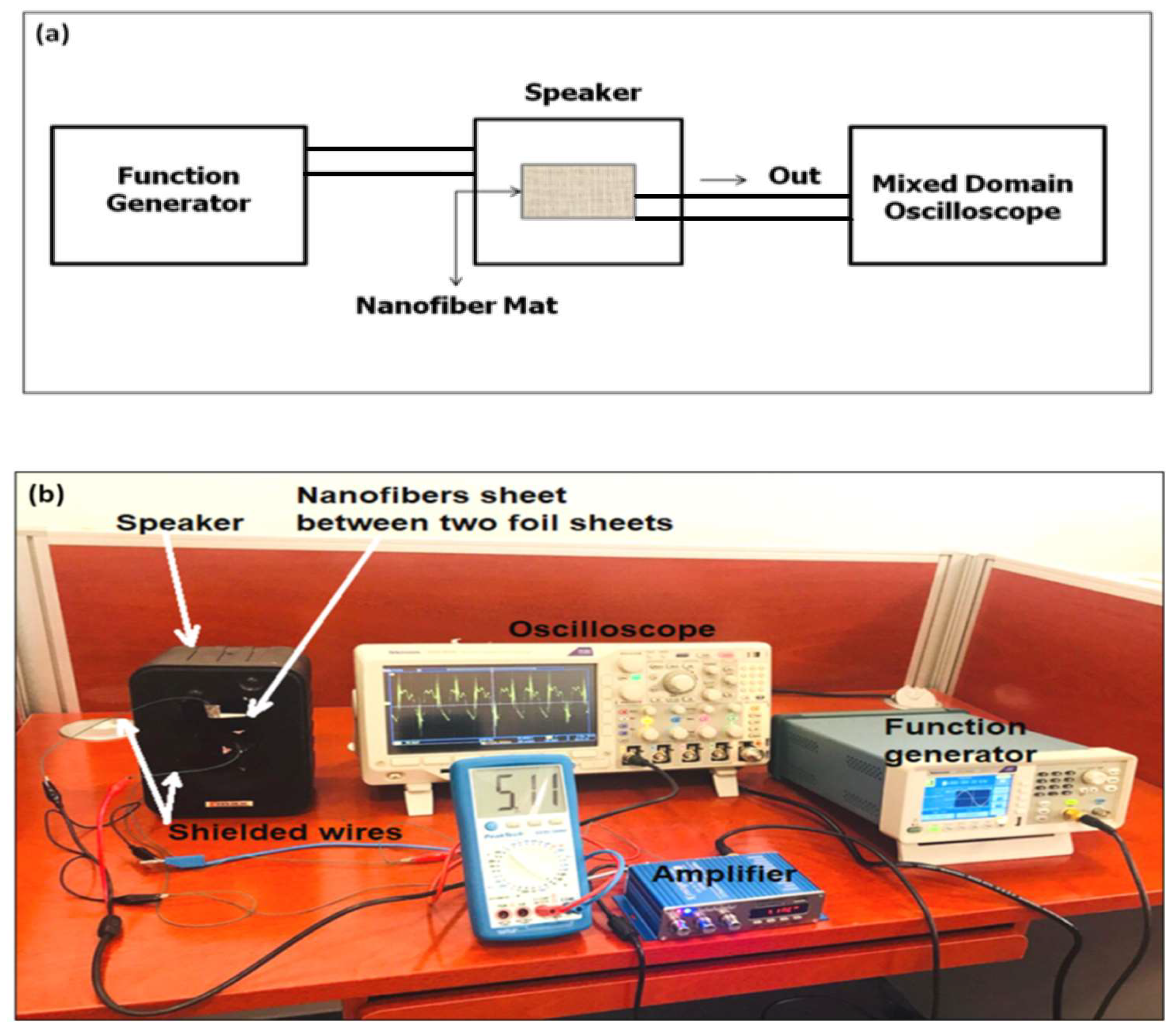
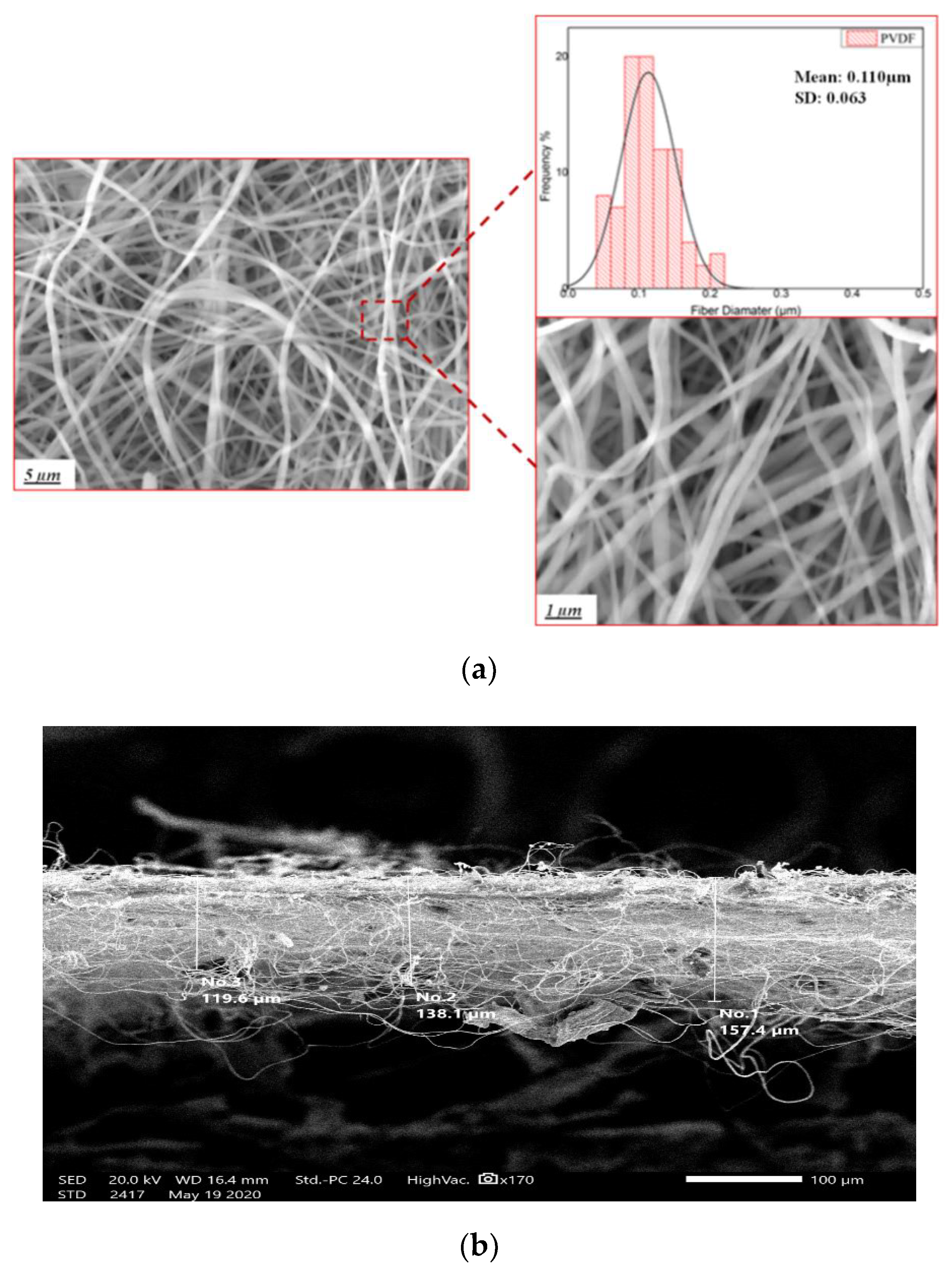
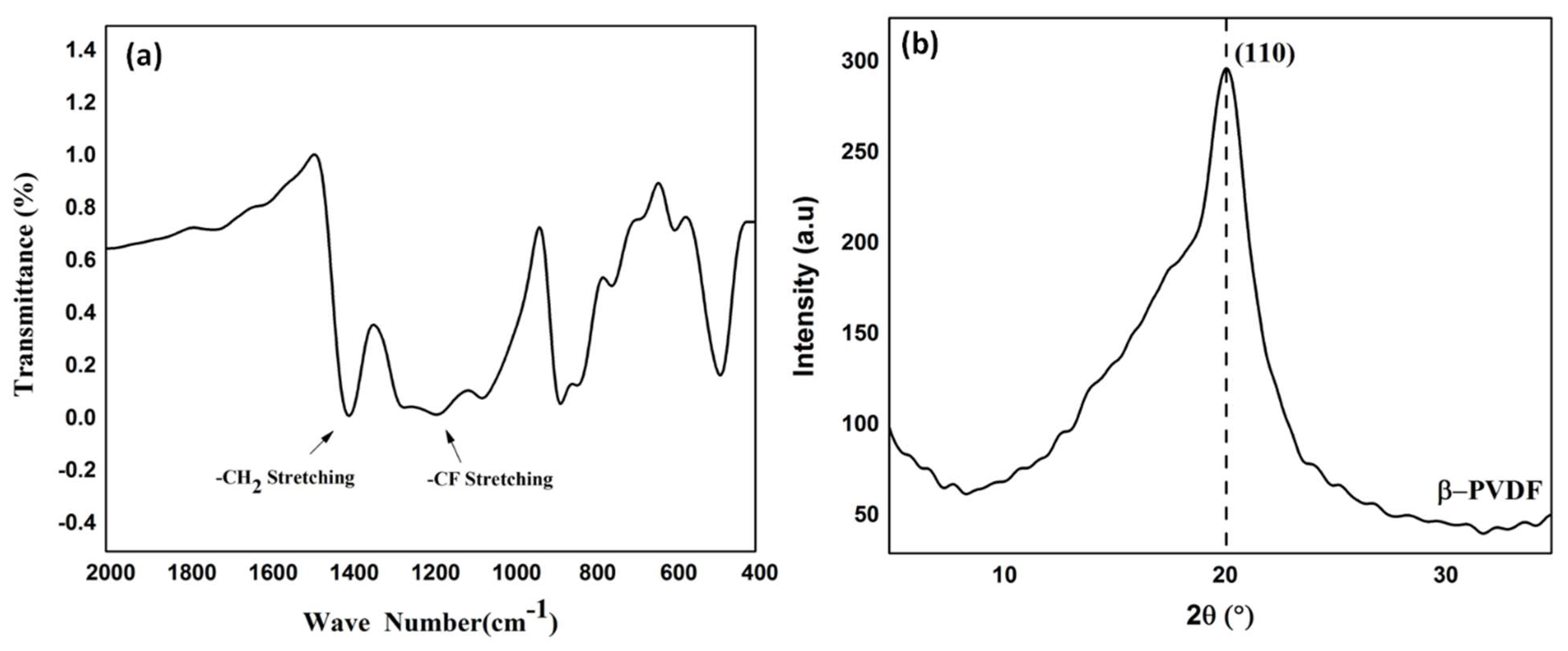

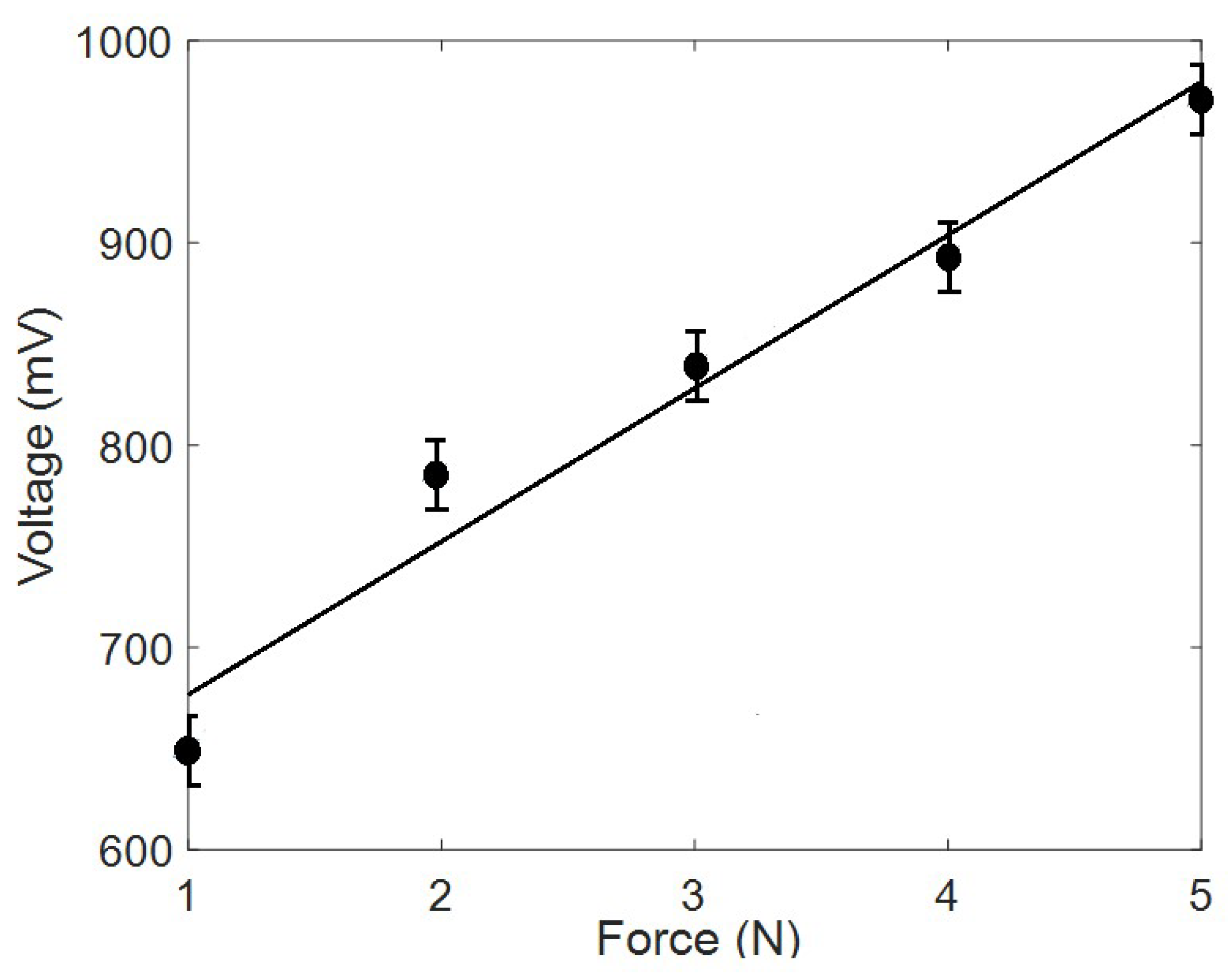
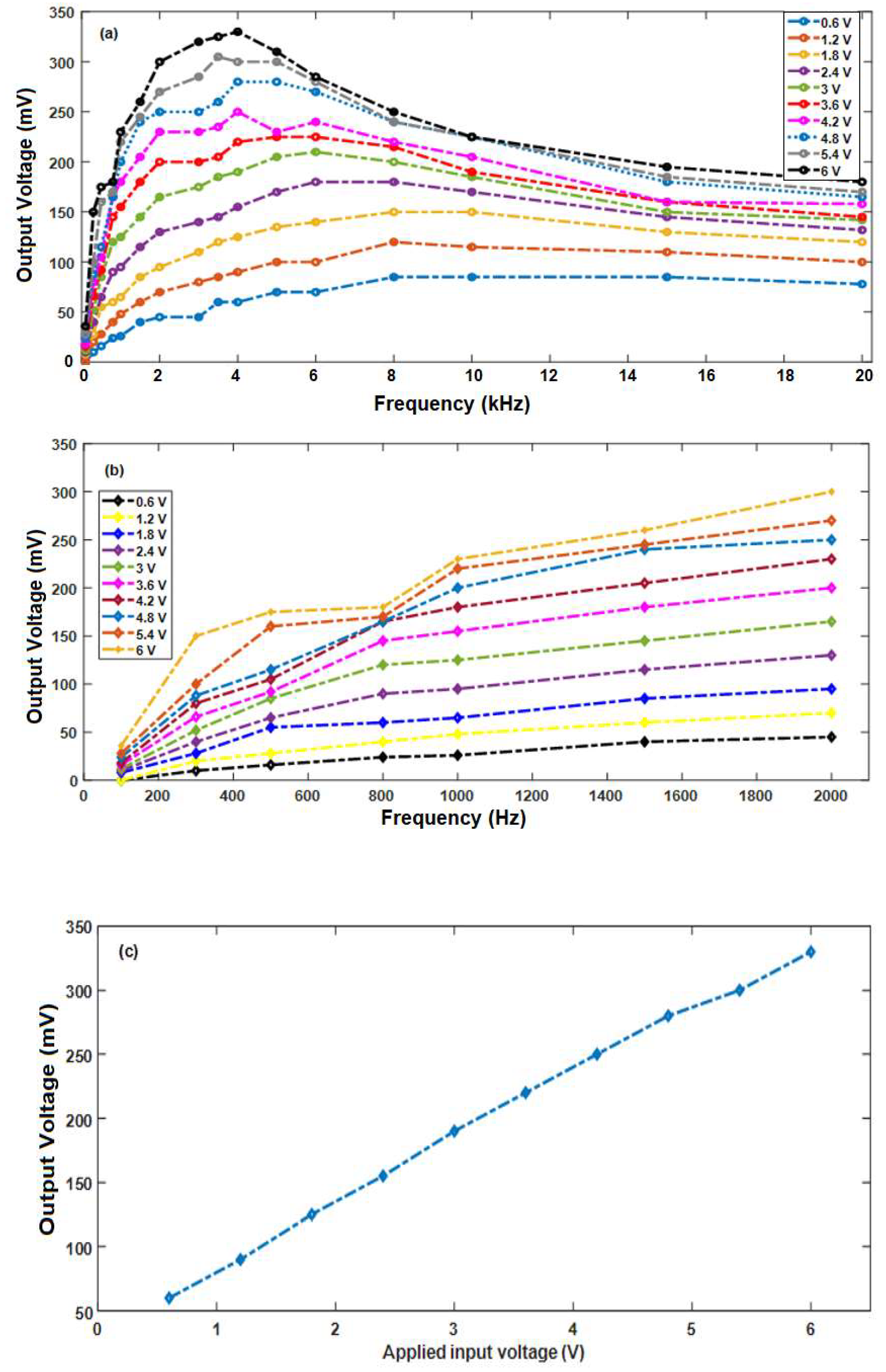

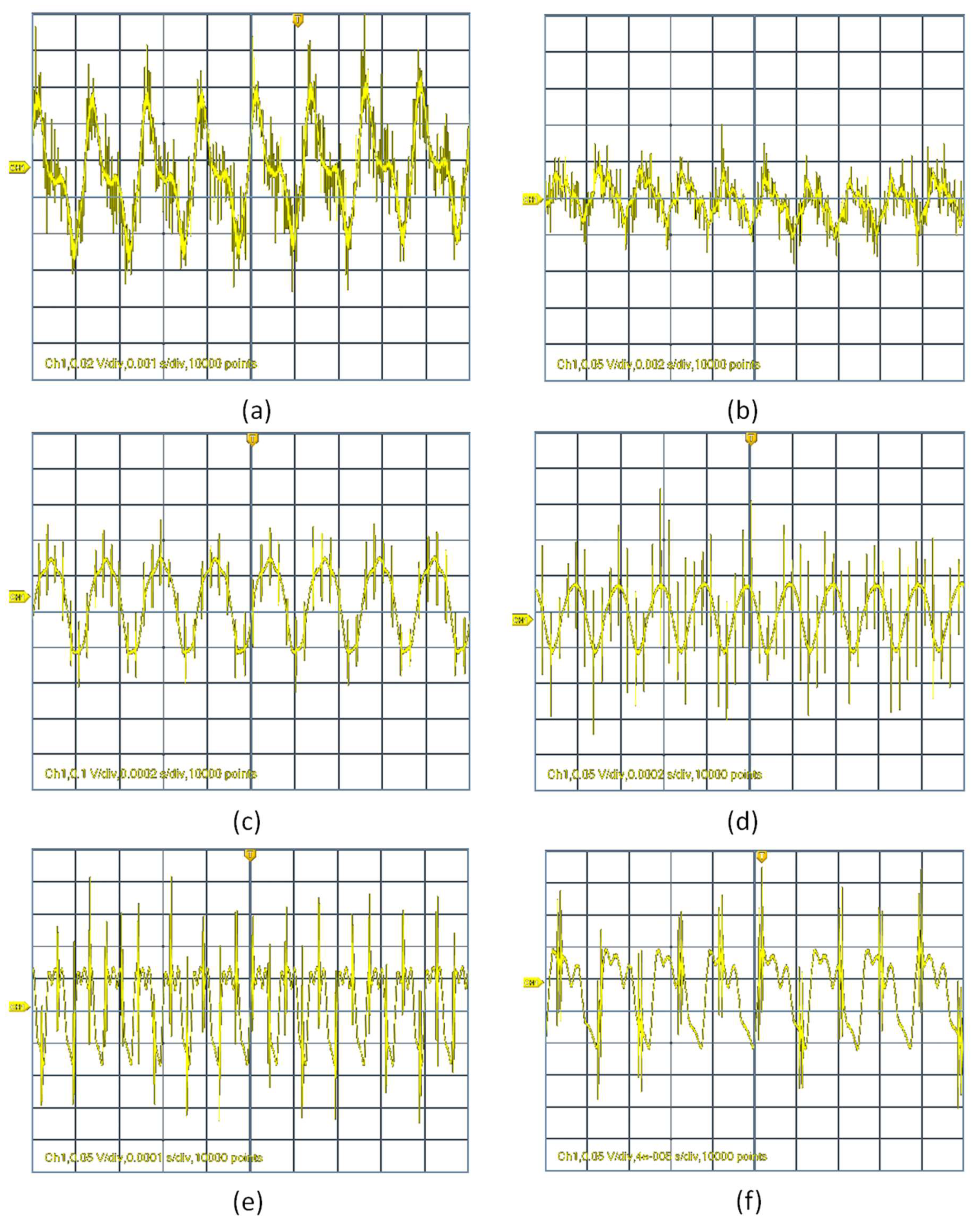
| Input Frequency (Hz) | Output Frequency (Hz) | Absolute Percentage Error (%) |
|---|---|---|
| 800 | 787 | 1.6 |
| 1000 | 990 | 1 |
| 3000 | 3012 | 0.4 |
| 6000 | 5924 | 1.2 |
| 8000 | 8012 | 0.15 |
| 10,000 | 9920 | 0.8 |
| 15,000 | 15,197 | 1.3 |
| 20,000 | 19,960 | 0.2 |
© 2020 by the authors. Licensee MDPI, Basel, Switzerland. This article is an open access article distributed under the terms and conditions of the Creative Commons Attribution (CC BY) license (http://creativecommons.org/licenses/by/4.0/).
Share and Cite
Shehata, N.; Hassanin, A.H.; Elnabawy, E.; Nair, R.; Bhat, S.A.; Kandas, I. Acoustic Energy Harvesting and Sensing via Electrospun PVDF Nanofiber Membrane. Sensors 2020, 20, 3111. https://doi.org/10.3390/s20113111
Shehata N, Hassanin AH, Elnabawy E, Nair R, Bhat SA, Kandas I. Acoustic Energy Harvesting and Sensing via Electrospun PVDF Nanofiber Membrane. Sensors. 2020; 20(11):3111. https://doi.org/10.3390/s20113111
Chicago/Turabian StyleShehata, Nader, Ahmed H. Hassanin, Eman Elnabawy, Remya Nair, Sameer A. Bhat, and Ishac Kandas. 2020. "Acoustic Energy Harvesting and Sensing via Electrospun PVDF Nanofiber Membrane" Sensors 20, no. 11: 3111. https://doi.org/10.3390/s20113111





